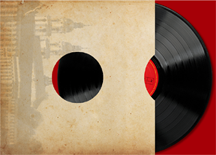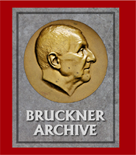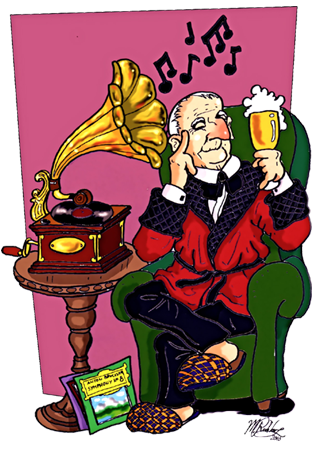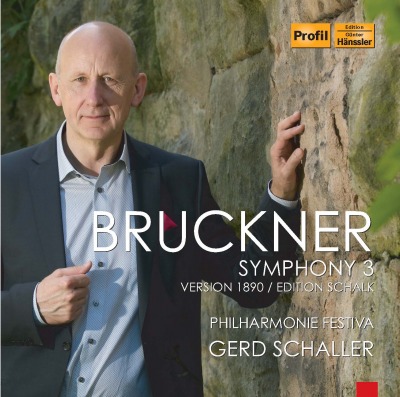Gerd Schaller's Recording of the 1890 "Schalk Edition" of the Symphony No. 3 is released.
As a note, his recording of the Symphony No. 3 in the boxed set is unique in that it is a variant of 1874 as prepared by William Carragan. The new recording gives us the edition that was published during Bruckner's lifetime by the publishing firm of Theodor Raettig. Bruckner was assisted in this publication by his disciple, Josef Schalk. Here are Schaller's notes on this new performance and recording: “I am still overwhelmed by the response from the Philharmonic audience, which must have called for me twelve times, and with such enthusiasm!...” (Anton Bruckner) Immediately after completing the Second Symphony, Bruckner continued a fruitful compositional spree by starting the draft of his Third. He had no way of knowing then that this work would continue to occupy him for the rest of his life. The Third is written in D minor, just like the early symphony that was not assigned a number and labelled as “nullified” in the composer’s autograph. One may assume that the audience at the work’s premiere had expected to hear something modelled on Beethoven’s Ninth Symphony. Let us not get ahead of ourselves, though. Back in the summer of 1873, Bruckner travelled to Bayreuth in order to visit Richard Wagner. He wanted to take the opportunity to dedicate one of his symphonies to Wagner, who could choose either the Second or the Third. Wagner picked the Third, which at the time contained many allusions to his own music. Curiously enough, the day after his memorable meeting with the “most revered master of all masters” Bruckner was not too sure which of the two symphonies Wagner had chosen. Bruckner sent a brief note to Wagner’s villa “Wahnfried” asking for confirmation: “Symphony in D minor, where the trumpet opens the theme. A. Bruckner”. Wagner immediately replied on the same note: “Yes! Yes! Best wishes, Richard Wagner”. This is how that sheet of notepaper from the Goldener Anker hotel in Bayreuth came to bear the signatures of the two famous composers. Once the dedication was made, the next challenge was to arrange a first performance. Just like the Second, the daring Third was rejected by the Vienna Philharmonic, several times actually, even though Bruckner kept making amendments, taking out many of the Wagner quotations in the process. The first performance was finally scheduled for 1877 but the unexpected death of Bruckner’s great promoter Johann Ritter von Herbeck left Bruckner having to take up the baton himself. The premiere proved to be one of the most awful debacles in music history. Nonetheless, the Viennese publisher Theodor Rättig approached the distraught yet astonished composer after the concert and offered to publish the “Wagner Symphony”. Bruckner revised the score again in 1888/89. The performance of the work under the conductor Hans Richter on December 21, 1890, was a resounding success. Bruckner himself reported to his later biographer August Göllerich: “I am still overwhelmed by the response from the Philharmonic audience, which must have called for me twelve times, and with such enthusiasm!...” Bruckner spent more time working on the Third than on any other symphony. His efforts yielded three versions that are now widely performed: the 1873 version, the 1877 version and the 1888/89 version. A number of other versions were written in between. One less wellknown version (1874) was first performed and recorded on CD in a Bruckner project run by the Ebracher Musiksommer festival in July 2011. The endless task of revising Bruckner’s work was in later years delegated to his pupils Franz and Josef Schalk. On June 10, 1888, Josef Schalk informed his brother that Bruckner was “unfortunately still working on the finale” and that his brother’s cuts and transitions had been accepted. On July 13, the anxious Josef reported that Bruckner had been “unnerved by Herr Mahler who had happened to be in Vienna” and “now wanted to have the old score printed again”. Bruckner wanted to turn everything on its head. Josef responded by lodging an “unauthorised veto” with the publisher, urging the publication to be postponed. This indecision caused poor Theodor Rättig considerable loss: 50 finished printing plates had to be destroyed. The work ended up being printed in the “final version” revised by Schalk. Conductors including Wilhelm Furtwängler and Hans Knappertsbusch performed the Schalk edition of the Third. It was not until musicologists started to engage critically with the original scores that this edition later started to appear obsolete. Josef and Franz Schalk’s alterations were deemed to be out of keeping with the work and were generally rejected. It should be remembered, though, that the sole intention of these Bruckner disciples was to help their master and promote the performance of his works. Sadly, they overshot the mark at times, as in the Fifth Symphony, which was completely reworked with significant changes to the instrumentation and shortened. The Third is however somewhat different on account of the long period over which it evolved. From today’s perspective it is thoroughly worthwhile to readopt this late version of the symphony since Bruckner’s own input in the score is still significant and plain to see. This edition clearly presents an impressive blend of Bruckner’s early and late styles. Over time, the form became more concentrated and the instrumentation more sophisticated. Bruckner constantly sought the perfect form in which to write his symphonies, hence the constant revisions. He himself frequently spoke of “improvements” and was in this respect surely influenced and unsettled by his peers. There were however further reasons for his sometimes volatile temper. Dissatisfaction, self-doubt and inner qualms had the dual effect of tormenting him and spurring him on. His aim was to write absolute music as Beethoven had envisioned it. Indeed, his Third Symphony “where the trumpet opens the theme” expresses this desire for absolute music without following any programme. Bruckner’s work (like the music of Beethoven and Wagner) is characterised by wonderfully dramatic escalations of sound. This is immediately evident in the first movement of the Third Symphony. The solo trumpet starts proudly, generating the solemn mood that is so unique to Bruckner. The first orchestral tutti booms after a long development. The lyrical secondary theme, the “Gesangsperiode” or “song section”, forms a contrast to the eruptive main theme. The secondary theme is characterised by the “Bruckner rhythm”, the linking of duplet and triplet figures. The development links and elaborates the various thematic elements. After the Classical reprise, the coda makes clear allusions to Beethoven’s Ninth Symphony. A great mass of sound builds up above the ostinato in the bass parts. The dreamy Adagio of the second movement is very expansive. Bruckner specifies that this movement should be “rather animated – Andante” and therefore not too slow. A prominent feature of the middle section is the “Marienkadenz” (cadence on the word “Maria”), a favourite device of Bruckner’s derived from his Ave Maria motet of 1856. The sentimental second theme has the character of an Allegretto. A tentative figure in the second violins opens the Scherzo and becomes more and more intense, culminating in an elemental whirl of sound. The Trio is dominated by a rustic viola melody and is extremely imaginative in its conception. The opening to the Finale is bizarre, a celebration of brass. The secondary theme is cast in a remarkable mould: the cheerful song of the violins is accompanied by a solemn chorale. Both ideas are played at the same time and interlaced. Bruckner stated that his intention here was to juxtapose the cheerfulness and the suffering of the world. The development is dramatic and impulsive. The concise reprise is followed by a concentrated coda. The trumpet motif of the first movement is restated, but now in a radiant apotheosis that dispels all the previous turmoil to complete the cycle. Gerd Schaller |






